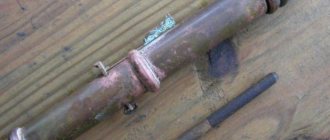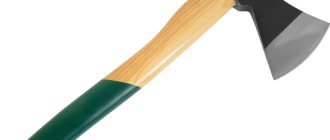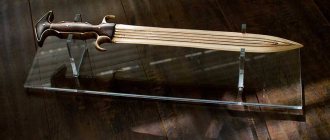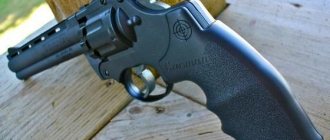It is believed that the word "tomahawk", which gave the ax its name, came from the incorrect pronunciation of the Indian word "tamahakan" - a cutting object.
In pre-Columbian America, the Indians used this word to describe something like “a stone with an elongated shape, sharpened on both edges and mounted on a wooden handle.” And this device didn’t look at all like how it all looks in movies about Indians. It was only with the discovery of America that the word “tomahawk” began to refer to metal axes.
Characteristics and Similarities of Tomahawks
Ax blades have many shapes that roughly resemble a wide variety of axes from different eras or spearheads that lie perpendicular to the shafts. Butts also have several shapes that resemble other axes, such as peckers. Some butts were in the form of hammers or hammers with pins, square and round sections.
However, there was also an ax in the form of a small halberd. Due to its functionality, the ax was used in battle, hunting, and also in everyday life - it was used to cut down trees. The Indians needed this ax only for close combat; they threw it at enemies extremely rarely.
Axes were thrown mainly as sports equipment during training. The functionality of battle axes made it possible to remove the blades from the shafts and use them as a knife. Such axes weighed within half a kilogram, the length of the cutting edges of the blades was up to 100 mm, and the length of the straight shafts was within half a meter.
Tomahawk on the pages of books and in movies
It is enough to read any book or watch any film about the exploration of America in order to evaluate the advantages and disadvantages of tomahawks. Quite often, these weapons are depicted as cranberries; the historical and ethnographic component is not respected.
In books written in hot pursuit by authors who saw tomahawks in person, like Mine Reid or Fenimore Cooper, these axes are given the attention they deserve.
Strong scenes of tomahawks being used in battle are shown by directors who are not shy about naturalistic scenes in films. Thus, the tomahawk plays an important role as the weapon of the main character of the film “The Patriot”.
The classic tomahawk has remained part of the original and interesting culture of the American Indians. A formidable military weapon, which is also a work of decorative and applied art, the tomahawk has become an object known to everyone.
The emergence of tomahawks
Due to the fact that the manufacture of metal axes was inaccessible to the Indians, they exchanged them from the “pale-faced” who appeared in that area at the beginning of the 17th century. Thus, the first tomahawks were steel and improved battle axes of the British Marines, used for boarding ships.
Spanish tomahawks were different from English ones. They had wide, moon-shaped, rounded blades. The French living in Canada were the first to make tomahawks in the form of klevets.
Birth
The Indian tribes, who lived in isolation for a long time, did not know how to process metal like the Europeans. This did not mean that the indigenous tribes did not fight or hunt.
When the pioneers became acquainted with Indian culture, they discovered interesting weapons. The Indians used a cross between a club and a battle ax as their main weapon. This weapon was called tomahigen and was a long wooden rod with a stone inserted on top.
Tomahigan was extremely common among the Indians, although it had many disadvantages.
The handle, made of flexible wood, often broke at the most inopportune moment of the battle. The narrow stone, the striking part, although guaranteed to pierce the head, got stuck in the bones of the skull.
Therefore, when the Indians became acquainted with the metal axes of the Europeans, their delight knew no bounds. The indigenous people willingly exchanged anything for axes, creating their own special culture of handling the battle ax.
The basis of metal tomahawks is the British axe, intended for boarding parties. The soldiers who arrived in the New World did not spare relatively cheap axes in exchange with the Indians. For sailors and Marine soldiers, these axes were commonplace, while for indigenous tribes it was a new word in weapons.
Tomahawks - a formidable weapon of the Indians
By exchanging provisions for axes, the Indians turned them into even more formidable weapons. They also learned the technique of using axes and significantly outperformed their teachers, especially in close combat. In throwing, they themselves became unsurpassed masters - all the axes they threw always hit the target from a distance of up to 20 meters.
The functionality of the axes allowed even weak people to use them thanks to the lever handles. The characteristics of tomahawks made it possible to operate both in the thick of battles and in one-on-one combat. In addition, wounded animals were killed with axes.
Disadvantages of modern models
Modern industry produces many types of tomahawks for every taste. From the frankly predatory SOG m48, to the quite peaceful-looking Jenny Wren Spike, advertised as women's. In general, modern tomahawks can be divided into three groups:
- Identical. Such axes are produced only by Cold steel. They are a forged hatchet on a wooden handle, put on using the reverse insertion method;
- Tomahawks attached to a plastic handle. This is the notorious SOG m48 and similar models;
- Tomahawks, cut from a single piece of metal, with pads in the handle area.
Modern tomahawk with plastic handle
Tomahawk made from a single piece of metal
Let's take a closer look at the advantages and disadvantages of each type.
The identical tomahawks are a classic ax design that has remained unchanged for hundreds of years. Usually they are made independently or ordered from blacksmiths. Despite their inconspicuous appearance, they are a formidable weapon, proven in many battles over the centuries. They are distinguished by a simple design, perfect balancing, the ability to adjust the handle specifically to your hand, and ease of repair. The ax itself is “indestructible”, and the handle is easy to make with your own hands.
Tomahawks on a plastic handle have a very menacing appearance. Thanks to their light weight, they can be used at high speed. The butt is often made in the form of a pecker, a hammer, or even a second blade. During operation, these axes revealed many shortcomings. The round handle often rotates in the hand when striking, which is why the blow turns out to be sliding. It is absolutely not suitable for throwing, despite the assurances of the sellers (the handle breaks after several hits against a tree). Practically unsuitable for household work. This type of tomahawk is better suited for intimidation than for serious work.
One-piece tomahawks can be called an ax with great stretch. Rather, these are blades shaped like an ax. Due to the design features and low weight of the working part, they are not capable of performing the role of a powerful piercing weapon. It rubs your hand a lot when using it. Their only advantage is their solid structure, which is very difficult to break.
Peace Tubes
Perhaps as the most common type of ax, we can talk about pipe tomahawks. Through channels were made in the shafts of the axes, and the upper parts of the shafts at the holes were plugged with round plugs made of wood, deer antlers, or even metals. Containers for tobacco were placed on the blades on the butt side. The result was an ax-pipe for smoking.
In addition, there were pipe tomahawks, which had sacred meaning. Specifically: “sacred pipes” or “peace pipes.” Special rituals were carried out with the participation of leaders and elders; ax pipes were lit in a circle, symbolizing reconciliation or the end of wars.
The “palefaces,” who respected local traditions, often used pipe axes. They were richly decorated as gifts to the leaders. The blades were engraved and the shafts were decorated with a wide variety of metal details.
Is a tomahawk a tool for survival or recreation?
The word "tomahawk" comes from the Native American word "otomahuk", meaning "to knock down." Although the tomahawk is similar in many ways to the common axe, their origins are very different. The tomahawk was originally used by the native Indians of North America as a weapon and tool for survival in the wild.
The working heads of such hatchets could be made of stones or even hard bones. The cutting edge could be in the shape of a hatchet, a beak, or a hammer. The location of the cutting edge could be either horizontal or vertical. For many years, the tomahawk was a universal tool that every true Indian had. Indians and mountaineers used the tomahawk for hunting, construction, cutting wood, and self-defense. Nowadays, tomahawks are more often used for entertainment or for throwing in competitions than for cutting wood or protecting against wild animals.
However, tomahawks (especially tactical ones) have the ability to replace numerous tools. Essentially, you can use it as a primary survival tool as well as other tactical tasks. It is a compact tool that anyone can easily use due to its simplicity. It is easy to carry with you - you can attach it to your belt, backpack or vest. Compared to large axes, it has two main advantages - it is lightweight and compact. This is exactly what makes it an ideal candidate for field use. Modern tomahawks have a wide range of applications, no matter where you are: hiking along the Kola Peninsula or patrolling in the Amazon jungle.
Whether you need to force your way out of an enclosed space, dismantle an old barn, rescue people from a burning building, or chop wood for an evening fire, the right tomahawk will get the job done quickly and efficiently. Let's look at some interesting options that you can buy today.
Touring ax Camp Ax - SOG CH1001, stainless steel, thermoplastic handle GRN, black
The tomahawk is made of forged stainless steel and is compact and easy to carry. Take a look at this beautiful tool and you'll think it's one of those items that will carry quite a bit of weight. However, it is not. The hatchet gives that impression, but it fits surprisingly easily between your belt and trousers and you'll hardly feel it's there. Yes! It is very light and very compact.
This camp hatchet boasts both ease of handling during use and ease of carrying while on the move. Which is especially important when driving over rough terrain. It is not designed for throwing, especially if you are starting to take your first steps. But if you have already mastered this technique, then it is quite possible to throw this tomahawk over short distances and it will fly very confidently.
If you regularly use an ax for power work, you will agree that a good, vibration-free, comfortable grip during use is very important. Manufacturers also understand this quite well, and therefore this model has a two-component handle made of materials of different densities, covered with a hard grooved rubber on top. The ax comes with a convenient and safe sheath to protect the cutting edge (though more likely to protect other objects from the sharp cutting edge).
Trench Hawk ax 25.0 cm
When choosing this rugged thing, it’s worth remembering right away that this tomahawk from Cold Steel is not child’s play or even just another shelf folder. This is a versatile "tactical machine" with a sharp cutting tip and spike. The tomahawk is sharp on both sides - very sharp, so you should handle this tool with care. Moreover, it is ready to use right from the moment of purchase - feel free to put it in the trunk of your car, toolbox or raid backpack.
It is worth noting that the blade is made of 1055 carbon steel. 1055 is an excellent choice for carbon steel that is strong and wear resistant. In addition, it has an optimal ratio between hardness and elasticity. Breaking such a tool is nearly impossible—tests show that the steel head of this tactical tomahawk will withstand the impacts and pressure of heavy use that would easily break other useful axes.
Another plus of this tool is that the steel head is easy to replace. The manufacturer does not specify why such a feature is needed - perhaps he plans to produce different working heads for one ax handle. It’s worth mentioning separately about the ax handle. It is made of proprietary Coldsteel polypropyl, which does not break. From the word “absolutely”. Under significant pressure (for example, being hit by a car), it bends and twists. But it doesn't break. The Tomahawk comes with an original hard plastic case that ensures safe storage and transportation.
CRKT 2735 Woods Kangee T-hawk Axe, 1055 Carbon Steel, Hickory Handle
The model from CRKT is another type of tomahawk that is as close as possible to authentic models. It won't win any design awards for its complex geometry or super hard steel. But it can handle any tough job, whether you are a firefighter, hunter, logger or climber. The hatchet has a forged head made of high-carbon, corrosion-resistant 1055 stainless steel and a durable hickory wood handle that is as pleasant to hold as it is to look at.
The T-Hawk is old school survival technique at its best. While it won't allow you to punch through car hoods, remove nails, or punch your way through drywall like some high-end tomahawks, it's great for basic physical duties like chopping and splitting wood, working with rocks, and working with ice. Such a tomahawk will find work in the forest (cutting trees, building a shelter, starting a fire). He will not be left without work in the garden plot (cultivating trees, cutting bushes and roots, working on stones). A good, basic tool for survival and work.
Ax - tactical tomahawk TACTICAL TOMAHAWK BLACK-SOG F01T, steel 420 Black Finish, thermoplastic handle GRN, black
Based on its set of characteristics, this model can be safely recommended for both beginners and more experienced tourists. The hatchet was created on the basis of tactical experience that SOG designers learned from the experience of a Vietnamese company. Over the last 30 years they have made a name for themselves by creating high quality specialty cutting tools, and their tactical tomahawks fit right in with the best of their products. SOG's Tomahawk design is clean, uncluttered, and has a clear emphasis on balance and cutting edge efficiency.
The working head is made of high quality 420 stainless steel and coated with a black oxide coating which helps it resist corrosion and scratches. The hatchet head attaches with 2 durable bolts to a handle made from glass-reinforced ballistic polymer that won't rust or rot no matter how many times you get caught in the rain, dropped in the mud, or dropped in water. The surface of the handle does not slip at all. The steel tip provides the handle with additional protection against splintering when the forces acting on the hatchet become excessive.
Tomahawk Trail Hawk
Cold Steel, as always, is true to himself - this tomahawk consists of a forged head mounted on a smooth wooden handle. Nothing superfluous - only functionality and no design. This is exactly how company founder Lynn Thomson sees a fully working tomahawk. However, these are the kind of axes that various survival specialists like to buy and then add what they think are necessary bells and whistles. Such as a braided wrap, safety end or heat shrink on the handle. None of this is needed, of course. This model is most efficient in this form.
This hatchet is actually much smaller in real life than shown in the photos, please take this into account when purchasing. This is a fairly compact and lightweight model. It uses an interesting system for attaching the head to the hatchet - a reverse conical hole. Thanks to this feature, the head rests on the handle without glue or wedges. The head is made of high carbon 1055 stainless steel, allowing for quick and efficient sharpening. You should pay attention to this model if you plan to go to the forest for a week or even more.
Tomahawk Hummer
This tomahawk showcases the beauty and simplicity of the classic tomahawk, takes simple design concepts and breathes new life into them, and creates a tomahawk that is reliable, easy to use, and built to last. The all-metal design allows you to perform a wide range of heavy-duty jobs - whether we are talking about pushing out doors or breaking through metal car hoods. The hatchet fits confidently in the hand due to the well-designed shape of the handle. An excellent model for those who already know exactly what they want from their next tomahawk.
Tomahawk Gerber Downrange Tomahawk
We left this hatchet (so to speak) for last, for dessert, so to speak. At the moment, this is perhaps one of the coolest and most famous tactical models. The first is, of course, a completely cool design. But behind this design there is advanced functionality. The Gerber Downrange Tomahawk is all you need for serious tactical operations.
Pressing the door and breaking the hinges is no problem. Knock down a padlock or break a mortise lock - please. And so on. So if your range of hobbies involves stalking, extreme hiking and the like, you should pay close attention to this option.
Missouri tomahawks
Until the 19th century, some of the most sought-after battle axes were “Missouri.” They got their name from the local Missouri River. A characteristic feature of such axes was the presence of a large blade, which turned into a simple butt with a round eye.
This served as the name for lug tomahawks. The presence of large surfaces of the blades made it possible to make shaped holes for a more attractive appearance. The supply of such axes was carried out by the French living in Canada. Their cheap production made it possible not to harden the blades, because these were battle axes.
Origin of tomahawks
The settlers supplied the Indians with metal axes and tomahawks. Most of the tomahawks are made in factories in Europe: in France, England, Holland and Spain. The Spaniards supplied the Indians with axes less than others. But other countries, along with the emerging USA and Canada, supplied hundreds of thousands of them. The Indians could make only the most primitive “things” on their own, but blacksmiths settled with them, who repaired and manufactured various iron objects.
It is believed that tomahawks with wide moon-shaped blades originated from the Spaniards. The British are characterized by various versions of ordinary hatchets. The French of Canada were the first to produce tomahawks in the shape of not a hatchet, but a claw - "". Initially, ordinary European axes came to North America and the Indians. But their parameters turned out to be not entirely suitable. Therefore, the process of selecting and creating our own options was underway. For example, the most popular form has become known even earlier to Europe as the “half-axe”. From about 1700, typical varieties of tomahawks were already widely produced. The bulk of the tomahawks of the eastern part were produced in 1740-1850. In the West they date back to 1830-1890.
The preferences of certain forms of tomahawks among Indians of different tribes changed over time and were determined by the proposals of manufacturers. The strikers or heads of tomahawks were originally made of iron and steel. Later they also began to use bronze or brass. Or a head was made of iron or non-ferrous metal, but a steel blade was inserted into the front part of the blade. Tomahawks made of plain iron without hardening were counterfeits that were sold to the Indians by deception. There were quite a few tube and esponton tomahawks made of soft metals - tin and lead. Moreover, they cannot be called decorative, since they were in use from the War of Independence until the very end of the 19th century.
Espontone battle axes
From English “spontoon tomahawks” is translated as espontoon tomahawks. A wide variety of configurations and sizes of battle axes had characteristic twisted appendages at the base of the blades. In the European army, only sergeants could possess such weapons.
The tomahawk shafts did not wedge. Thanks to this, the metal parts of the ax blades could be removed from the shafts and used as combat knives. In addition, such blades were often attached to war clubs that were used by the Indians.
In most cases, cavities were made in esponton tomahawks, like in tubular axes. Sometimes one came across a number of earless espontone axes, similar to the ancient axes of the Celts.
Tomahawk modification
There are a large number of tomahawks used at different times by representatives of different tribes and organizations.
Earless:
- celts, similar to the first tomahawks of the Indians, but made of metal;
- celts with a point.
Ear:
- Missouri military axes, the head of which in most cases was simply a cut piece of sheet metal;
- tubular with a through channel inside the handle;
- espontone, descended from a polearm with the same name, which was used by officers of European armies;
- with a point or hammer;
- trade axes, used in the fur trade and so named because of this;
- halberd, resembling halberds in appearance.
There are many other tomahawks mentioned in the literature, but these are the most famous.
Tomahawk: modern copy.
Step 1: Raw Materials
After studying the history of the tomahawk, creating a drawing and studying its modifications, you can begin making the tool. The first step is to prepare the materials. To make a tomahawk with your own hands you will need:
- axe;
- wooden block;
- wedge;
- leather, feathers and other details for decoration.
Step 2: Creating the Blade
Tomahawk: manufacturing process.
It is necessary to draw the desired shape on the head of the old instrument. It is worth making it smaller, since tomahawks have a smaller head size and were used by the Indians for throwing.
In addition, it will be lighter, which is a big advantage of the tomahawk.
After selecting the shape, it must be cut out. This can be done using a grinder, after holding the ax in a vice.
Step 3: removing paint from the blade
Metal cleaning products.
If the original ax contains paint, it should be removed. Paint stripper can be purchased at a hardware store.
By following the instructions, you can quickly obtain pure metal. But when working with such substances, you should be careful, as there is a risk of getting a chemical burn.
Step 4: Boil the ax blade in vinegar
This process will make the ax look aged. You need to cook it in white vinegar for 20 minutes, preferably in an old, unnecessary container. It is worth ventilating the room during the cooking process, as the smell can cause dizziness, and it itself is not particularly pleasant.
Step 5: Making the Handle
As with the head, markings are applied to the block, along which the handle of the future tool is cut out.
The appearance of the handle depends on the choice of the creator: it can be a classic round shaft or a handle made to the shape of the owner’s hand
. In this case, it is better to make the handle a little larger, because it can be ground off if necessary.
Step 6: putting the blade on the handle
To fit the head onto the ax handle, it will have to be sanded and adjusted to the size of the eye. The main thing here is not to overdo it, otherwise you will have to cut out a new handle, and this is a waste of time and material.
You need to put it on tightly.
Step 7: Finishing Touch
Here it is at the discretion of the creator. If necessary, you can decorate the tomahawk with various feathers, carvings or leather braiding. Afterwards, you can grind and consider the tool ready.
Step 8: Put it all together
Now that the components are ready, it's time to assemble the tomahawk. You need to put the head on the handle, drive a wedge so that it does not fly off, decorate it with feathers, leather and other things if desired, and the tool is ready!
Trade tomahawks
Trade tomahawks are the simplest and cheapest ax of all the tomahawks. They are characterized by the fact that the blades, turning into simple butts, were flat or rounded and were used as hammers.
There were also types of axes whose blades were double-sided. The shafts were inserted both above and below the holes, based on the types and shapes of the axes. Due to their shape, they were called “half-axes”, since they were very small in size.
The Indians used these mini-axes mainly for agricultural work, although also for war. Such axes were supplied by the manufacturing countries themselves: England, France, and Holland.
Drawing for making a tomahawk with your own hands
Now you can start manufacturing. The first step towards assembling your own metal hatchet is to create a drawing and study it. It should contain the dimensions of the handle and head, since they are the main parts.
Halberd-type tomahawks
From English “halberd tomahawks” is translated as halberd tomahawks. These are exact copies of halberds, but with short handles. Mainly used in trade with the natives. The shafts were secured using cone-shaped bushings. This method of fastening was borrowed from copies.
At the ends of the ax shafts there were metal bayonets shaped like a sharp cone. The metal parts of the blades were solid, there were no slots. The shape of the blades was wide and semicircular on one side. While the other side and the top resembled a flat point.
Halberd tomahawks were in the “assortment”. Some had no points on top, and some had chisel-shaped points. In some, the points were replaced by curved hooks, spikes or smoking cups.
There were models with collapsible heads that could be screwed onto vertical bushings with threaded points. In addition, each of the points could be attached, of course, if there was a cut thread. There were also tomahawks that did not have bushings for the shafts, since they were entirely metal.
Later, tomahawks with shafts made of brass and other metals appeared. They were inserted into sockets and riveted using rivets. Such shafts had a wide variety of shapes. They were flat, round, pointed at the ends.
Despite the fact that these products were not convenient for use in battle, the Indians used such axes to demonstrate their belonging to the leaders, because the presence of such axes was a sign indicating the status of the leader.
How and what were tomahawks made from?
Initially, Europeans brought axes intended for work. These were ordinary, strong steel products, widely distributed and used throughout the world. In order for more axes to fit during transportation, they were laid without a handle.
Getting to the Indians in exchange for furs and other valuables, European designs were subjected to “deep modernization” in accordance with the Indians’ ideas about beauty.
The large wide blade was ground down for ease. The tomahawk, which got its name from the European-style transcription of an Indian word, was often and successfully thrown by Indian warriors at the enemy. The butt changed, it was lengthened, turning into a bite.
Sometimes a recess was made in it for tobacco, a hole was drilled through the handle, complementing the functions of the ax, making it a pipe for smoking. True, such axes were not used in hand-to-hand combat, leaving them as diplomatic equipment.
Since ax suppliers, as well as tribes, varied greatly, there are several of the most popular types of tomahawks:
- eye axe, the most famous type of tomahawk, promoted by cinema;
- tubular, described a little above;
- esponton variants, usually obtained as trophies from sergeants and officers of the colonial troops, were distinguished by their large mass, unsuitable for throwing;
- halberd tomahawks were obtained in the same way as in the version described above, but the basis was an already shortened halberd, rarely found in lands where there were no Spanish conquistadors.
The idea of Indian beauty was fully reflected in tomahawks. The handles were decorated with carvings and ornaments. Feathers, fangs of predators, and scalps of defeated enemies were hung as talismans and amulets.
The blade and butt were also subjected to painting, chasing and other delights worthy of jewelry from the time of the European Great Migration.
Main types of tomahawks
There were also battle axes-tomahawks, with hammers on the butts, or tomahawk-hammers, very similar to pipe axes, but not as elaborate as trade axes with hammers on the butts. Such axes were used not only by the Indians, but also by North American settlers, as well as colonist riflemen, who used them as belt axes.
Axes with points or hooks on the butt side are peak tomahawks, similar to boarding axes. Athapascan clubs can also be classified as tomahawks. These were products made from deer antlers with protruding branches into which points were inserted from whatever was at hand.
What varieties did the Indian tomahawk ax have?
Although the tomahawk for ordinary people is associated with the so-called “Missouri axe,” the type of tomahawk could be different and was divided into:
- Celts. The very first iron tomahawks, which were driven into the handle with a butt. This group also includes celts with a point, more like klevets; Ear tomahawks. Exactly those that were advertised by cinema and books about Indians. Also called "Missouri axes," they were the traditional form of an ax with an eye. Used for combat, very rarely in everyday life (mainly for quickly cutting up carcasses); Pipe tomahawks. They could be of any type, but they had a special feature - a channel along the entire length of the handle. Often richly decorated, they were rarely used in battle due to the hollow handle. Their main purpose was in diplomatic ceremonies between tribes; they were often given as a sign of friendship; Espontone tomahawks. They were a mixture of exhibiton and axe. Most likely, they were remade from exhibitons taken in battles with settlers; Halberd tomahawks. They were brought from Spain and were either shortened halberds or hatchets made according to the same pattern. The rarest variety, the North American Indians had them mainly among the leaders, emphasizing their status.
Along with these models, there were homemade tomahawks. They were usually made from standard models.
Tomahawks of our days
Despite the fact that almost 200 years have passed, tomahawks are still relevant today due to their functionality. Mainly attention was paid to them before the Vietnam War.
Peter Lagano, a well-known Indian at that time who served in the American army, managed to develop a peak tomahawk battle ax that could be thrown quite well.
Currently, the tomahawk ax can be used in tourism and in some sports, but most often it can be seen as a historical reconstruction.
The history or life of the tomahawk?
The chronicle of the tomahawks, despite the defeat of the redskins, did not end. In the US Army, battle axes, which trace their roots back to the tomahawks of the Indian War, were used in all conflicts in the 20th and 21st centuries.
This weapon gained particular popularity during the Vietnam War.
A special enterprise was created to produce weapons, but in the 1970s, due to the hostility of the war by American society and the end of hostilities, the plant collapsed.
Meanwhile, the improvement of hand-to-hand combat techniques required tactical tomahawks for the army. The war in Iraq, Afghanistan, and all operations of the US Army and its allies could not take place without this simple and effective weapon.
But modern tomahawks have a number of disadvantages. Products with a plastic handle often slip and tend to escape from the hand. After several blows, the ax jumps off the handle and spins at the end, making it impossible to deliver an accurate blow.
Throwing such a tomahawk means throwing it away, since any plastic dies after several throws. All-metal tomahawks are often unable to penetrate strong defenses, and also rub your hand when chopping.
Indian armor
Traditional Indian warfare was also influenced by another “white man’s gift”—the horse. The animal that, in fact, created the prairie Indians, who later turned out to be the hardest nut to crack for the American army.
But even earlier, the Indians of Arizona, Texas, and New Mexico received horses from the Spaniards. The first horsemen were the Apaches. Following the example of the Spaniards, they began to dress their horses in leather “armor” (Apache warriors, by the way, used such leather “armor” for a long time for their own protection.
In general, Indian warriors protected themselves in battle with leather shields; the Indians of the northwest used helmets made of wood). The Apaches, thus having the best equipment for war, were later able, as the Jesuit Masne says in his message of 1691, to defeat all the neighboring tribes.











